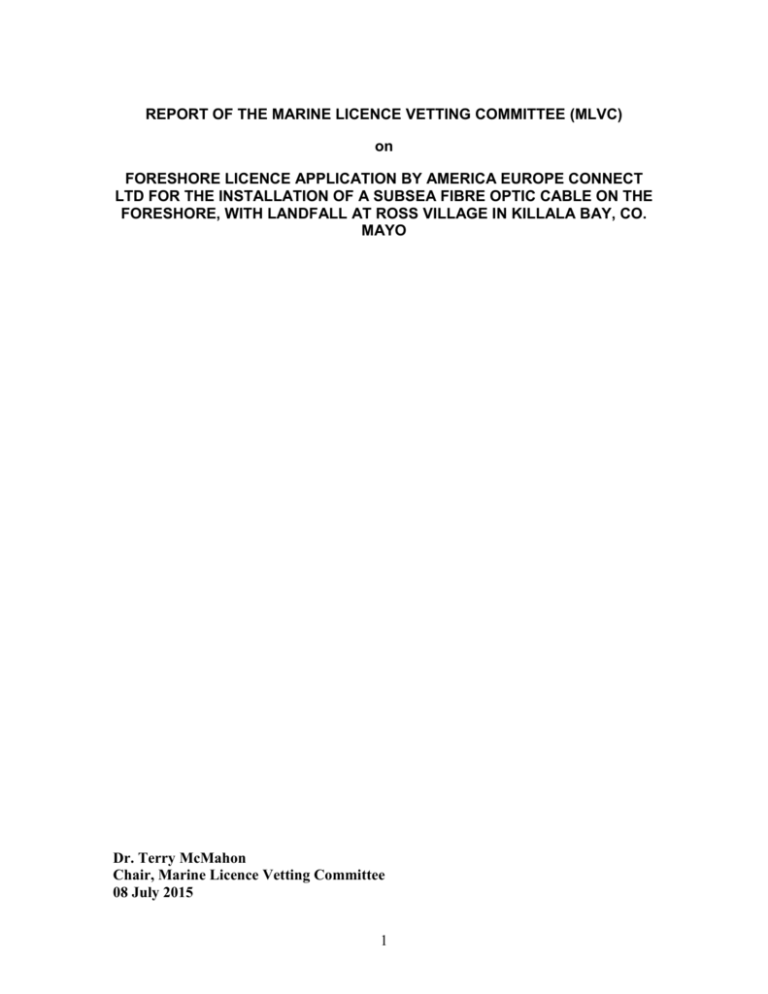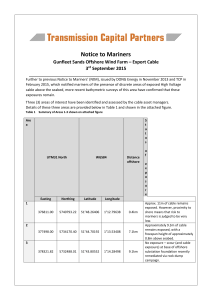MLVC report - Department of Environment and Local Government
advertisement

REPORT OF THE MARINE LICENCE VETTING COMMITTEE (MLVC) on FORESHORE LICENCE APPLICATION BY AMERICA EUROPE CONNECT LTD FOR THE INSTALLATION OF A SUBSEA FIBRE OPTIC CABLE ON THE FORESHORE, WITH LANDFALL AT ROSS VILLAGE IN KILLALA BAY, CO. MAYO Dr. Terry McMahon Chair, Marine Licence Vetting Committee 08 July 2015 1 America Europe Connect Ltd - Foreshore Licence Application for the installation of a subsea fibre optic cable on the foreshore, with landfall at Ross village in Killala Bay, Co. Mayo (FS006942) Background In February 2015 America Europe Connect Ltd submitted an application for a Foreshore Licence to facilitate the installation of a subsea fibre optic telecommunications cable on the foreshore. The works are part of a project involving the installation of a subsea fibre optic cable system, 5,250km in length, extending from Long Island in the USA to Ireland with landfall at Ross village in Killala Bay, Co. Mayo. It is intended that the subsea cable would be linked via an on-shore cable network in Ireland with further high capacity links to the UK and mainland Europe. The proposed cable route on the foreshore is shown on Drawing No. 1251-207 entitled “Foreshore Licence Map”, dated 29/02/2015 submitted by the applicant. Details are also shown on the following Drawings submitted by the applicant: Drawing No. 1251-204, entitled “Mainlay Offshore Route”, dated 16/02/2015 Drawing No. 1251-205, entitled “Mainlay Inshore Route”, dated 16/02/2015 Drawing No. 1251-206, entitled “Mainlay Landfall ”, dated 16/02/2015 A predecessor to the current applicant, Emerald Networks Ltd, received a Foreshore Licence for Site Investigations at the site on 8/5/2014 (Ref FS 6280) .These works have been completed. The offshore cable route is circa 15Km north of the Corrib Gas field and subsea pipeline to shore. There are no other subsea cables in vicinity of the proposed cable route and there will be no cable crossings. Part of the proposed cable route, in the inshore area within Killala Bay from approximately KP1 to landfall, lies within the Killala Bay / Moy Estuary SAC (Site Code 000458) and the Killala Bay / Moy Estuary SPA (Site Code 004036). Cable Installation Details of the proposed cable installation route and methodology are provided in the document entitled “Application for Foreshore Licence for main-lay installation of America Europe Connect Fibre Optic Cable: Planning Report” dated February 2015, prepared by MDM Consultants and submitted by the applicant. 2 Pre-lay Grapnel Run A pre-lay grapnel run, to clear debris from the seabed along the installation route, is proposed prior to cable installation. This is standard practice. The swathe width of the grapnel is < 1m and impacts on the seabed are considered to be minimal and not significant. All debris recovered from the seabed will be stored on board the vessel used to carry out the pre-lay grapnel run and will be disposed of onshore. Inshore Beach Manhole A Beach Manhole is to be constructed onshore at the existing hard stand area at Ross Strand. The manhole will be 3m x 2m x 2m and is to be constructed in reinforced concrete. It is anticipated that construction time would be in the order of 1 week. A section of duct will be installed at a depth of 1.5m from the Beach Manhole to the top of the slipway. The existing macadam surface will be saw-cut, the trench will be excavated, the duct will be installed and the trench will be backfilled immediately. The macadam surface will be reinstated on completion of the backfill. It is anticipated that these work would take 2 days to complete. Cable Installation on the beach The shore end operation will involve the excavation of the trench on the beach at Ross Village. It will commence with removal of the stones forming part of the upper shore, as necessary and storing these to one side. The excavation of the trench will be carried out from the slipway to the LWM. It will continue until the target depth of 1.5m is achieved in the sediment. A short section of duct will be placed beneath the storm beach. Ocean Ground Bed It is also intended to install and an “ocean ground bed” on the beach at Ross Village. The ocean ground bed is a set of electrodes which provides the return path for the electrical circuit that powers the repeaters in the submarine cable system. The ocean ground bed is typically buried at least 2m below beach level and is effectively a 6m long trench that would be backfilled and reinstated in one tidal cycle. The Ocean Ground Bed will be buried in the beach adjacent to the cable It is intended that the above works would be carried out in August 2015 Cable Installation – Pre-Lay Shore End Seaward from the Low Water Mark to approximately 10m below CD, the subsea cable will be buried by means of seawater jetting systems. The jets are directed into the seabed 3 by the burial tool, emulsifying the seabed in the region for burial and a trench is formed. The jetting system slowly moves along the seabed on the required cable track, making the trench into which the cable is placed. Cable installation will be carried out by a cable ship, or shallow water vessel, stationing offshore near its minimum working depth. A messenger line will be hauled ashore and a winch, located near the Beach Manhole will pull the cable through the pre-installed duct and into the manhole. The cable will then be lowered into the excavated trench and the trench backfilled. Any disturbed areas of the beach landing will be restored to their original pre-construction condition. The cable installation element of the works is generally completed in one tidal cycle. Main Cable Lay It is intended to use a single cable ship to lay the cable. On arrival at the Pre Lay Shore End cable position, the streamed cable end on an anchor is retrieved by the cable vessel, either by use of divers or grappling, and the shore end recovered to make a joint to the main system cable onboard. The jointing process takes approximately 18-24 hours to complete including tests of the cable system, through to the terminal station, once the joint is complete. During the main lay and ploughing operations there are two methods associated with the cable laying: Cable burial – where the cable is required to be buried to protect it from potential threats e.g. from fishing, anchoring in depths less than 1500m for this project. It is intended that a sea plough deployed from the main cable lay vessel will be used for cable burial. The target cable burial depth for the main lay operation is 1.5m for this project. Surface laying – where the submarine cable is laid onto the surface of the seabed. This procedure is carried out in water where the cable cannot, or is not required to, be buried e.g. at cable/pipeline crossings or in areas where the seabed is too hard for the burial tool and at depths greater than 1500m for this project The target burial depth for the America-Europe Connect cable system is 1.5 metres for main lay Operations It is anticipated that the cable lay operation would be completed within a 2 week period Post Lay Inspection Following the main lay operations, a post-lay inspection and burial programme may be carried out in certain areas to inspect the proper laying and burial of the cable in the seabed. The amount and locations of the buried cable to be inspected will be determined based on the performance of the main lay operations. In the areas requiring post lay burial, a separate Remotely Operated Vehicle (ROV) is utilised. The ROV typically uses a jetting tool to bury the cable to the required depth. 4 The majority of the proposed cable route does not lie within a designated Natura 2000 site. The landfall site at Ross Village in Killala Bay is, however, located within the Killala Bay and Moy Estuary SAC (Site Code 000458) and the Killala Bay and Moy Estuary SPA (004036) Public Consultation A public notice concerning this application was published in the "Western People” and the “Irish Independent” on 23rdMarch 2105. The relevant documents were on display at Ballina Garda Station, Co. Mayo and were also available on the DECLG Web Site. The public consultation period ran from 23rd March – 22nd April, 2015. One submission was received. This submission, from Councillor J. Munnelly, expressed support in principle for the development but made the following observations: Care must be taken that in laying the cable, local fishermen are consulted with at all times. If local fishermen are to be inconvenienced as a result of this, there should be some consideration of this. Can it be confirmed that the cable, once in place, does not bear any impediment to fishing. It is the case that there will be no restrictions around the path of the cable (for fishing, etc). Is there any maintenance requirements for this cable? All efforts must be taken to ensure that minimum environmental disturbance is created during the construction phase (as acknowledged in the environmental reports). .MLVC Considerations The following documents were considered: Foreshore Licence Application and accompanying “Planning Report” (prepared by MDM Consultants, dated February 2015) which included Appended “Natura Impact Assessment& Ecological Assessment and Marine and Intertidal Ecological Impact Assessment Report”, prepared by Altemar Ltd (dated 16th February 2015) and “Marine Archaeological Assessment: Final Report (dated July 2014) and Marine Archeo-Geophysical Assessment Final Report (dated June 2015) prepared by Geomara and submitted by the applicant. Written submissions from DEHLG (Water Services Advisor), Inland Fisheries Ireland, Marine Survey Office, Marine Institute, DAFM (Aquaculture and Foreshore Management Division) and DAHG (Developments Application Unit). There were no objections to a licence being issued. Written submission received during the Public Consultation period. 5 MLVC Conclusions The MLVC concludes that, subject to compliance with the specific conditions set out below, the proposed works would not have a significant negative impact on the marine environment, would not adversely impact on marine Natura 2000 sites, would not have a significant impact on other legitimate uses / users of the area in the vicinity of the cable route and there recommends that a permit be issued. Proposed Licence Conditions 1. The Licensee shall use that part of the Foreshore the subject matter of this licence for the purposes as outlined in the application and for no other purposes whatsoever. 2. The Licensee shall notify the Department of the Environment, Community and Local Government at least 14 days in advance of the commencement of the works on the foreshore. 3. The cable shall be installed as detailed in the submitted “Planning Report: February 2015” unless otherwise approved by the Department of the Environment, Community and Local Government. Method Statements for all construction operations on the foreshore shall be submitted by the Licensee and agreed with the Department of the Environment, Community and Local Government prior to the commencement of any works. 4. The ‘’Ocean Ground Bed ‘’ shall be installed as set out at Section 6.15 of the ‘’Planning Report: February 2015’’. A drawing detailing the “as laid location” for the said ‘’Ocean Ground Bed’’ shall be submitted to Department of the Environment, Community and Local Government on completion of the works on the foreshore. 5. The Licensee shall ensure that the target burial depth for the length of the near shore (beach, shallow and intertidal zones to LWM) foreshore involved shall be at least 1.5 M as per Application documents with a target minimum depths for offshore burial as set out in the Application documents. 6. All material/debris collected as a result of the proposed pre-lay grapnel run shall be disposed of on shore to a licensed Landfill site in accordance with the 6 appropriate Waste Disposal Legislation subject to the appropriate agreement and approval of the relevant Local Authority 7. During the course of the works in the inshore / beach area at the landfall site the working areas shall be secured from unauthorised public access or encroachment by means of suitable barriers and signage and the Licensee shall comply with all relevant safety legislation in this regard. 8. The Licensee shall ensure that public access arrangements to the general foreshore area at Ross beach are not impeded by any vehicle/ plant/equipment or materials used in connection with the works and where relevant this access should be made safe and guaranteed by the provision of appropriate signage, notices or barriers to the satisfaction of the Department of the Environment, Community and Local Government. 9. The Licensee shall be fully compliant with the requirements set out in the NPWS Document “Guidance to Manage the Risk to Marine Mammals from Man-made Sound Sources in Irish Waters” (January 2014) in respect of the cable installation activity on the foreshore. 10. The mitigation measures set out in documented entitled “ Marine and Intertidal Ecological Impact Assessment for the American-Europe Connect Ltd. transAtlantic fibre optic cable landing in Killala Bay, Co. Mayo (Supplement Appendix to NIS)” dated 16th February 2015 shall be implemented in full. 11. The Licensee shall adopt appropriate methods of operation in order to ensure that no spillages of hydrocarbons, cement or other hazardous substance occur to the Foreshore during the course of the works. Contractors arrangements for the control of pollutants should be notified to Department of the Environment, Community and Local Government and Inland Fisheries Ireland (Ballina) prior to the commencement of works. 12. The Licensee shall liaise with the Irish Coast Guard to arrange appropriate Radio/nav-text broadcast warnings to advise shipping approaching the works area. 13. The Licensee shall furnish the names/registered number of all vessels involved in the operation to the Marine Survey Office in Dublin to ensure compliance with respect to Irish Load line and other relevant vessel certification. 14. The Licensee shall arrange the publication of a Marine Notice, issued by the Irish Maritime Administration, giving a general description of operations and approximate dates of commencement and completion. 7 15. The Licensee shall arrange the publication of a local marine notice giving general description of operations and approximate dates of commencement and completion in respect of near shore and landfall cable laying operations 16. The Licensee shall engage the services of a suitably qualified archaeologist to carry out an inter-tidal survey of the landfall, incorporating metal detector survey, under licence from the Department of Arts, Heritage and the Gaeltacht. This survey shall be carried out well in advance of the proposed construction works. 17. An Exclusion Zones of 100 metres shall be established around the furthest known extent of all anomalies (EECS-S5RVG-SC002, EECS-S5-RVG-SC001, EECSS5-RVG-MC004, EECS-S5-RVG-MC003, EECS-S5-RVG-MC002, EECS-S5RVG-MC001, EECS-S5-RVG-MC005 & EECS-S5-RVG-MC006) listed on pages 35 and 36 of the report entitled “AEConnect Cable System Irish Territorial Waters Marine Cultural Heritage Assessment”. A chart showing the route of the cable in relation to the anomalies and associated exclusion zones shall be supplied to the Department of Arts Heritage and the Gaeltacht in advance of the works proceeding. The Licensee shall put in place procedures to ensure that anchoring activities taking place during the works do not impact upon the exclusion zones. 18. In order to ensure the preservation of potential archaeological sites, wrecks and features the Licensee shall engage the services of a suitably qualified maritime archaeologist to monitor all in water disturbance works associated with the development including beach preparations works and foreshore works at the landfall, pre-lay grapnel run operations and cable burial operations. The archaeological monitoring shall be licensed under the National Monuments Acts 1930-2004. 19. A detailed method statement shall accompany the licence application and shall include details on the proposed works, duration of works; archaeological monitoring team proposed and a find’s retrieval strategy. 20. Should archaeological material be found during the course of monitoring, the archaeologist may have work on the site stopped, pending a decision as to how best to deal with the archaeology. The Licensee shall be advised by the National Monuments Service with regard to any necessary mitigating action (e.g. preservation in situ, dive and/or geophysical survey or excavation). The licensee shall facilitate the archaeologist in recording any material found 21. The Department of Arts, Heritage and the Gaeltacht shall be furnished with a report describing the results of the monitoring. 22. On completion of the works on the foreshore the Licensee shall ensure that all vehicles, plant, equipment and materials are removed from the foreshore. 8 23. The Licensee shall ensure that the foreshore and adjacent seashore and beach area shall be restored to its original condition on completion of the beach manhole, Ocean Ground Bed and cable installation. 24. No open excavation shall be left on the foreshore. 25. A chart and a route position list detailing the “as laid location” of the cable shall be provided to the Department of the Environment, Community and Local Government on completion of the works. Information on the location where the cable has been of “buried” and “surface laid” shall be provided. 9







